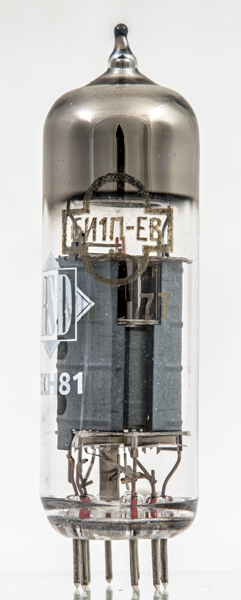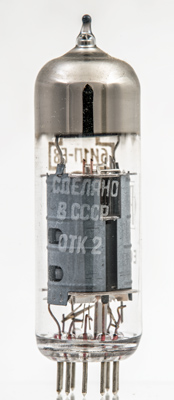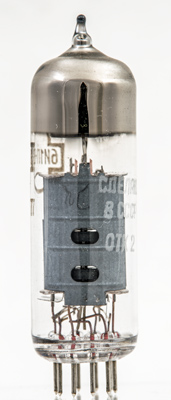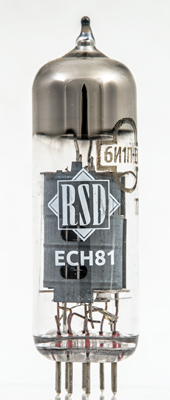|
6И1П-EBSensibly equivalent¶ to:
|
|
|

|
The 6И1П-EB is the Russian designation for the ECH81 triode heptode. It was designed in 1954 for the role of frequency changer (mixer) in superhet receivers for AM reception. The valve acting as oscillator and mixer for AM and the heptode being the first IF amplifier on FM.The two valve sections share a common cathode. The triode is to be used as the local oscillator feeding the 13 Volts amplitude sine wave to the heptode mixer. Within the heptode, non linear operating causes the signals to interact to produce in the anode waveform the following major frequencies: signal, LO, signal + LO and signal minus LO. The anode circuit is tuned to enhance one of these signals, normally signal minus LO. For radio reception at the time an intermediate frequency of 455 KHz would be typical for AM.RSD were a German company, Frankfurt area, that was a distributor/reseller of valves, often manufactured in Eastern Europe or Russia. The RDS logo can be seen as an overprint to the original etched identification.
The identification of the valve made in the Soviet Union (CCCP) supplemented by the Army quality control stamp OTK 2.
Through the solid screen can be seen the strap joining the two halves of the anode.
The distributor overprint logo RSD and the Type designation ECH81.The thin glass tube envelope is 22 mm in diameter and, excluding the B9A base pins, is 70 mm tall.References: 4051 & 1040. Type 6И1П-EB was first introduced in 1950. See also 1950 adverts. |
Pin Connections
| 1 | 2 | 3 | 4 | 5 | 6 | 7 | 8 | 9 |  g2,g4 | g1 | k,g5,s | h | h | a | g3 | a(t) | g1(t) |
|
|
Absolute Maximum Operating Conditions¶
| Vh | Ah | Va | mAa | 
| 6.3 | 0.3 | 100 | 13 |
|
Absolute Maximum Operating Conditions¶
| Va | Vs | Vg | mAa | mAs | ra | gm | 
| 250 | 250 | -2 | 6.5 | 3.8 | 0.7M | 0.775 |
|
Updated January 24, 2023.
|
|